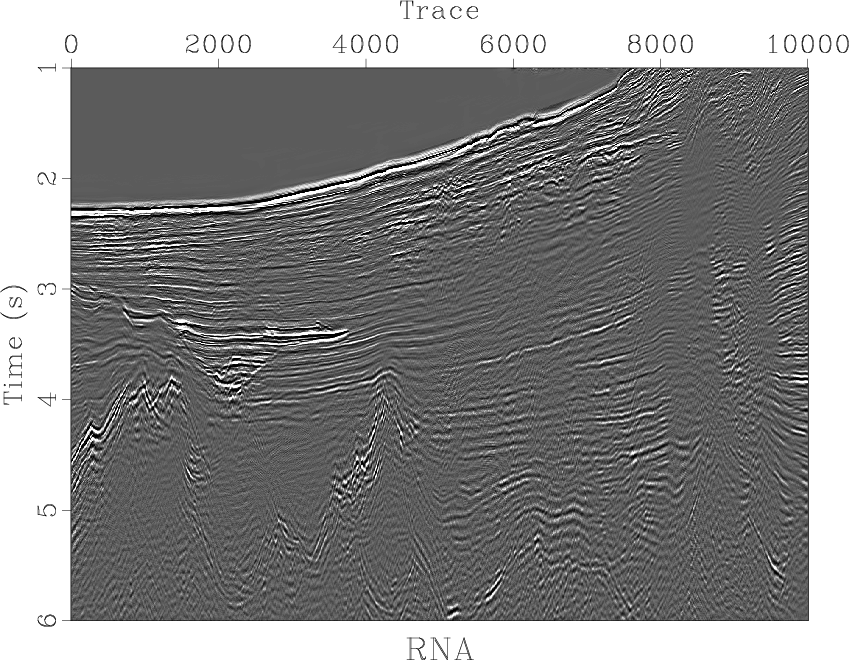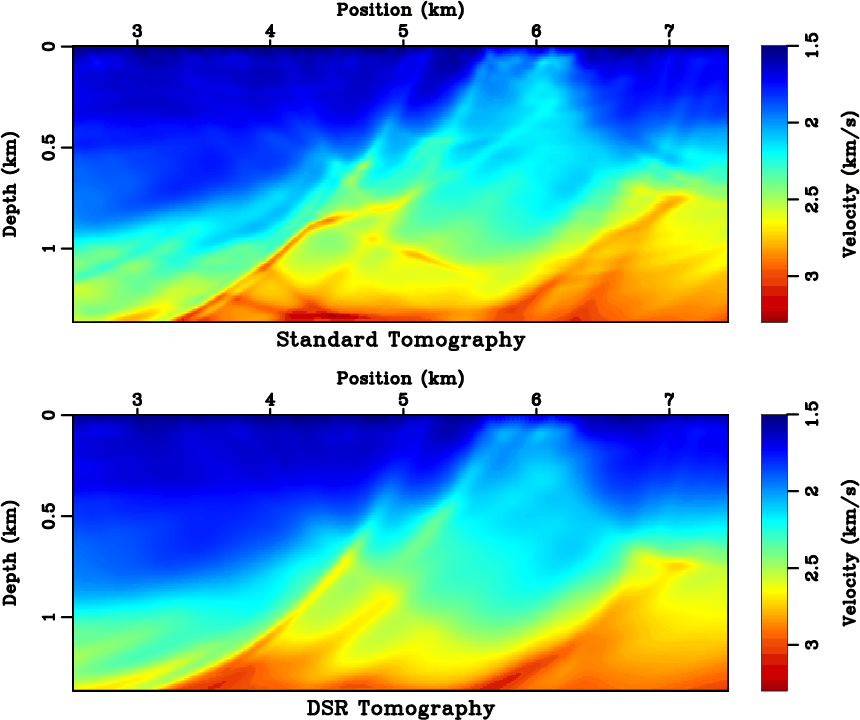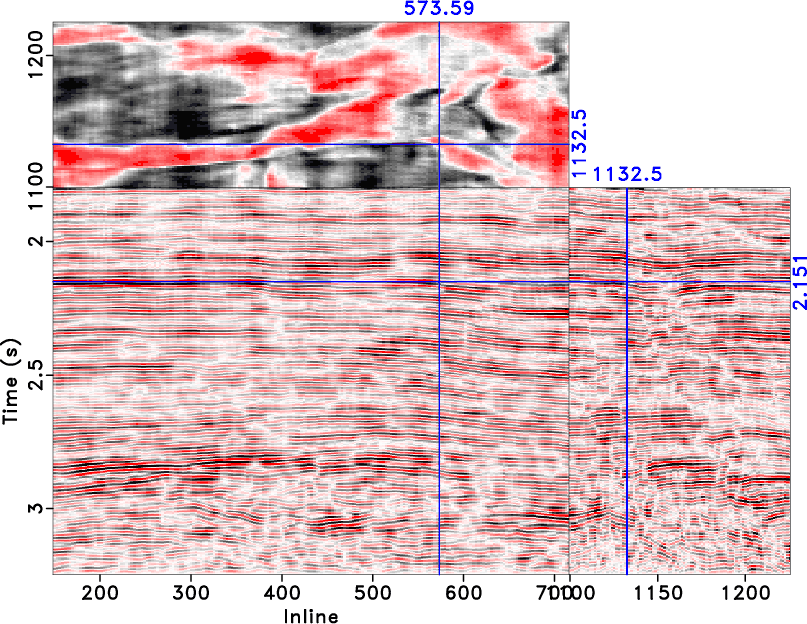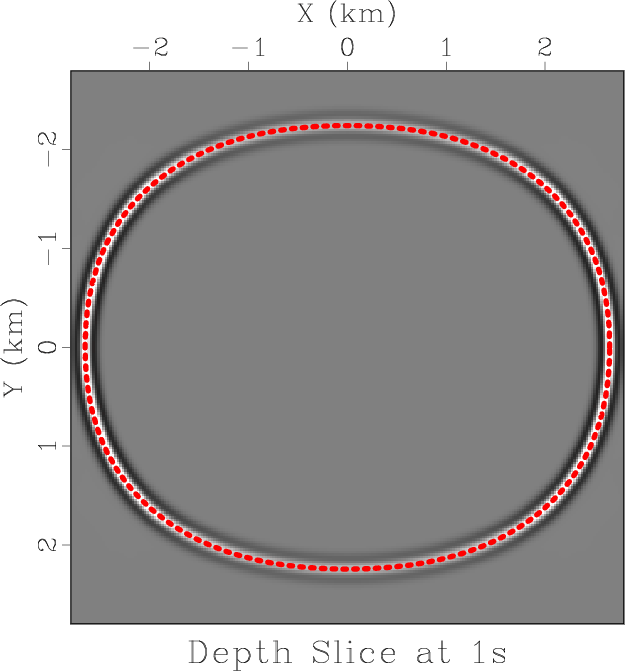 Inspired by projects such as the Khan Academy, Jon Claerbout is recording short videos narrating his book, Geophysical Image Estimation by Example. You can reproduce computational examples from the book (translated from Ratfor to C) by following its Madagascar version.
Inspired by projects such as the Khan Academy, Jon Claerbout is recording short videos narrating his book, Geophysical Image Estimation by Example. You can reproduce computational examples from the book (translated from Ratfor to C) by following its Madagascar version.
Geophysical Image Estimation by Example
November 18, 2013 Documentation No comments
3-D random noise attenuation using f-x-y NRNA
November 13, 2013 Documentation No comments
A new paper is added to the collection of reproducible documents:
Noncausal f-x-y regularized nonstationary prediction filtering for random noise attenuation on 3D seismic data

Seismic noise attenuation is very important for seismic data analysis and interpretation, especially for 3D seismic data. In this paper, we propose a novel method for 3D seismic random noise attenuation by applying noncausal regularized nonstationary autoregression (NRNA) in f-x-y domain. The proposed method, 3D NRNA (f-x-y domain) is the extended version of 2D NRNA (f-x domain). f-x-y NRNA can adaptively estimate seismic events of which slopes vary in 3D space. The key idea of this paper is to consider that the central trace can be predicted by all around this trace from all directions in 3D seismic cube, while the 2D f-x NRNA just considers the middle trace can be predicted by adjacent traces along one space direction. 3D f-x-y NRNA uses more information from circumjacent traces than 2D f-x NRNA to estimate signals. Shaping regularization technology guarantees the nonstationary autoregression problem can be realizable in mathematics with high computational efficiency. Synthetic and field data examples demonstrate that, compared with f-x NRNA method, f-x-y NRNA can be more effective in suppressing random noise and improve trace-by-trace consistency, which are useful in conjunction with interactive interpretation and auto-picking tools such as automatic event tracking.
Random noise attenuation using f-x RNA
November 12, 2013 Documentation No comments
A new paper is added to the collection of reproducible documents:
Random noise attenuation using f-x regularized nonstationary autoregression


We propose a novel method for random noise attenuation in seismic data by applying regularized nonstationary autoregression (RNA) in frequency-space (f-x) domain. The method adaptively predicts the signal with spatial changes in dip or amplitude using f-x RNA. The key idea is to overcome the assumption of linearity and stationarity of the signal in conventional f-x domain prediction technique. The conventional f-x domain prediction technique uses short temporal and spatial analysis windows to cope with the nonstationary of the seismic data. The proposed method does not require windowing strategies in spatial direction. We implement the algorithm by iterated scheme using conjugate gradient method. We constrain the coefficients of nonstationary autoregression (NA) to be smooth along space and frequency in f-x domain. The shaping regularization in least square inversion controls the smoothness of the coefficients of f-x RNA. There are two key parameters in the proposed method: filter length and radius of shaping operator. Synthetic and field data examples demonstrate that, compared with f-x domain and time-space (t-x) domain prediction methods, f-x RNA can be more effective in suppressing random noise and preserving the signals, especially for complex geological structure.
This paper is the first direct contribution from China University of Petroleum (Beijing).
DSR eikonal tomography
October 16, 2013 Documentation No comments
A new paper is added to the collection of reproducible documents:
First-break traveltime tomography with the double-square-root eikonal equation

First-break traveltime tomography is based on the eikonal equation. Since the eikonal equation is solved at fixed shot positions and only receiver positions can move along the ray-path, the adjoint-state tomography relies on inversion to resolve possible contradicting information between independent shots. The double-square-root eikonal equation allows not only the receivers but also the shots to change position, and thus describes the prestack survey as a whole. Consequently, its linearized tomographic operator naturally handles all shots together, in contrast with the shot-wise approach in the traditional eikonal-based framework. The double-square-root eikonal equation is singular for the horizontal waves, which require special handling. Although it is possible to recover all branches of the solution through post-processing, our current forward modeling and tomography focus on the diving wave branch only. We consider two upwind discretizations of the double-square-root eikonal equation and show that the explicit scheme is only conditionally convergent and relies on non-physical stability conditions. We then prove that an implicit upwind discretization is unconditionally convergent and monotonically causal. The latter property makes it possible to introduce a modified fast marching method thus obtaining first-break traveltimes both efficiently and accurately. To compare the new double-square-root eikonal-based tomography and traditional eikonal-based tomography, we perform linearizations and apply the same adjoint-state formulation and upwind finite-differences implementation to both approaches. Synthetic model examples justify that the proposed approach converges faster and is more robust than the traditional one.
Seismic data decomposition into spectral components
October 9, 2013 Documentation No comments
A new paper is added to the collection of reproducible documents:
Seismic data decomposition into spectral components using regularized nonstationary autoregression

Seismic data can be decomposed into nonstationary spectral components with smoothly variable frequencies and smoothly variable amplitudes. To estimate local frequencies, I use a nonstationary version of Prony’s spectral analysis method defined with the help of regularized nonstationary autoregression (RNAR). To estimate local amplitudes of different components, I fit their sum to the data using regularized nonstationary regression (RNR). Shaping regularization ensures stability of the estimation process and provides controls on smoothness of the estimated parameters. Potential applications of the proposed technique include noise attenuation, seismic data compression, and seismic data regularization.
Ray tracing on GPU
October 9, 2013 Documentation No comments
A new paper is added to the collection of reproducible documents:
Shortest path ray tracing on parallel GPU devices

A new parallel algorithm for shortest path ray tracing on graphics processing units was implemented. This algorithm avoids the enforcing of mutual exclusion during path calculation that is found in other parallel graph algorithms and that degrades their performance. Tests with velocity models composed of millions of vertices with a high conectivity degree show that this parallel algorithm outperforms the sequential implementation.
This is a contribution from Jorge Monsegny, UP Consultorias, and William Agudelo, ICP-Ecopetrol.
Spectral recomposition
August 9, 2013 Documentation No comments
A new paper is added to the collection of reproducible documents:
Automated spectral recomposition with application in stratigraphic interpretation

Analyzing seismic attributes in the frequency domain is helpful for reservoir characterization. To analyze the reservoir interval of interest in detail, it is important to capture the seismic response at each frequency subset. Spectral recomposition can be used to extract significant components from the seismic spectrum. We propose a separable nonlinear least-squares algorithm for spectral recomposition, which estimates both linear and nonlinear parts automatically in separate steps. Our approach is applied to estimate fundamental signal parameters, peak frequencies and amplitudes, with which the seismic spectrum can be reconstructed. Automated spectral recomposition helps us visualize frequency-dependent geological features on both cross sections and time slices by extracting significant frequency components. Spectral recomposition can also indicate how frequency contents attenuate with time.
Omnidirectional PWD
August 9, 2013 Documentation No comments
A new paper is added to the collection of reproducible documents:
Omnidirectional plane-wave destruction

Steep structures in seismic data may bring directional aliasing, thus plane-wave destruction (PWD) filter can not obtain an accurate dip estimation. We propose to interpret plane-wave construction (PWC) filter as a line-interpolating operator and introduce a novel circle-interpolating model. The circle-interpolating PWC can avoid phase-wrapping problems, and the related circle-interpolating plane-wave destruction (PWD) can avoid aliasing problems. We design a 2D maxflat fractional delay filter to implement the circle interpolation, and prove that the 2D maxflat filter is separable in each direction. Using the maxflat fractional delay filter in the circle interpolation, we propose the omnidirectional plane-wave destruction (OPWD). The omnidirectional PWD can handle both vertical and horizontal structures. With a synthetic example, we show how to obtain an omnidirectional dip estimation using the proposed omnidirectional PWD. An application of the omnidirectional PWD to a field dataset improves the results of predictive painting and event picking, as compared to conventional PWD.
Butterfly algorithm for generalized Radon
July 26, 2013 Documentation No comments
A new paper is added to the collection of reproducible documents:
A fast butterfly algorithm for generalized Radon transforms

Lowrank modeling in orthorhombic media
June 25, 2013 Documentation No comments
